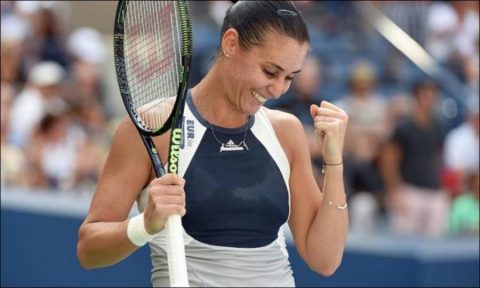This is nothing more than a very delicate slice or chop shot, made with the racquet head tilted backward about halfway between the slice and the lob techniques. It requires quite a little wrist flick, very little backswing, and a fair follow-through. The racquet head must meet the ball fairly solidly, but pass under it imparting distinct backspin. The shot definitely rises in the air and should have a safe clearance of a few feet above the net line at the top of its arc. It must fall within eight feet or less of the net to be of any real value.
If your shot goes too deep, it is just a setup. Be careful when you play it, and above all do not play it too much. Its greatest chance of success lies in its element of surprise, which, obviously, will be lost if it is overused.
The drop shot is most effective after you have run a man into a deep corner, Then drop the ball cross-court within about eight feet of the net and close to the far sideline.
The effects of the drop, like those of the slice, are cumulative. It is comparatively easy to reach in the first set, but after you have chased drops of ten enough for four sets, they begin to look a long way off.
Both the half-volley and the drop shot vary greatly in effectiveness with the court surface, and in exactly opposite ways. The half-volley is a comparatively easy shot and very effective on wood and hard courts, like concrete. The trueness of the court surface and the fact that spin takes little hold make it easy to time your shot, but on grass and day, which are slower and not so true, the half-volley becomes extremely hard to time and dangerous to play. On the other hand, the drop shot, with its backspin and soft pace, is deadly on clay and grass, but on hard courts and wood, where the spin doesn’t hold and the bound is higher, it is useless unless absolutely perfectly disguised.
So ends the section dealing with the strokes of tennis. I have pointed out their techniques and main uses. Let me once more sound a warning against thinking that strokes themselves mean everything, or make a good tennis player. You may hit a ball with perfect form, look like a million dollars on the court, and be a complete walkover for an opponent. I have tried to stress the need to think on every shot. Never hit a ball without a definite idea of how it will affect you-and your opponent. While it is essential to know how to hit a tennis ball, in every stroke it is the why, where, and when of it that wins tennis matches.
Now that you have an idea of the strokes and how they can be used, you are ready to take up the most important things in tennis-the tactics and psychology of the game.
How are matches won, and what is it that turns a loser into a winner? The next section deals with those factors, which change a person from somebody who plays tennis into a Tennis Player, and perhaps into a Champion.
